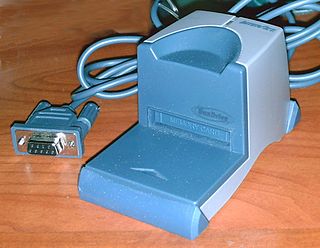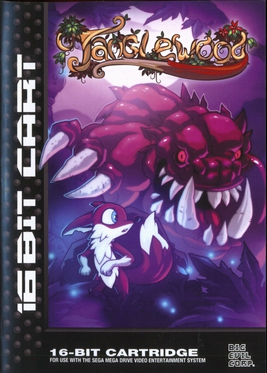
A video game or computer game is an electronic game that involves interaction with a user interface or input device to generate visual feedback from a display device, most commonly shown in a video format on a television set, computer monitor, flat-panel display or touchscreen on handheld devices, or a virtual reality headset. Most modern video games are audiovisual, with audio complement delivered through speakers or headphones, and sometimes also with other types of sensory feedback. Some video games also allow microphone and webcam inputs for in-game chatting and livestreaming.

A video game console is an electronic device that outputs a video signal or image to display a video game that can be played with a game controller. These may be home consoles, which are generally placed in a permanent location connected to a television or other display devices and controlled with a separate game controller, or handheld consoles, which include their own display unit and controller functions built into the unit and which can be played anywhere. Hybrid consoles combine elements of both home and handheld consoles.
Deathmatch, also known as free-for-all, is a gameplay mode integrated into many shooter games, including first-person shooter (FPS), and real-time strategy (RTS) video games, where the goal is to kill the other players' characters as many times as possible. The deathmatch may end on a frag limit or a time limit, and the winner is the player that accumulated the greatest number of frags.

The Family Computer Disk System, commonly shortened to the Famicom Disk System or just Disk System, is a peripheral for Nintendo's Family Computer home video game console, released only in Japan on February 21, 1986. It uses proprietary floppy disks called "Disk Cards" for cheaper data storage and it adds a new high-fidelity sound channel for supporting Disk System games.

River City Ransom, known as Street Gangs in PAL regions, is an open world beat 'em up video game originally for the Nintendo Entertainment System. It is an English localization of Downtown Nekketsu Monogatari for the Famicom. The game was developed by Technōs Japan and released in Japan on April 25, 1989.
A console game is a type of video game consisting of images and often sounds generated by a video game console, which are displayed on a television or similar audio-video system, and that can be manipulated by a player. This manipulation usually takes place using a handheld device connected to the console, called a controller. The controller generally contains several buttons and directional controls such as analogue joysticks, each of which has been assigned a purpose for interacting with and controlling the images on the screen. The display, speakers, console, and controls of a console can also be incorporated into one small object known as a handheld game.

Rock n' Roll Racing is a vehicular combat-based racing video game developed by Silicon & Synapse and published by Interplay Productions for the Super Nintendo Entertainment System in 1993 and the Mega Drive/Genesis in 1994. The game prominently features a number of popular heavy metal and rock songs in its soundtrack, hence the game's title. The game was ported to the Game Boy Advance in 2003. In celebration of the company's 30th anniversary, Rock n' Roll Racing was re-released for Microsoft Windows, Nintendo Switch, PlayStation 4 and Xbox One as part of the Blizzard Arcade Collection in February 2021.

"Game over" is a message in video games which informs the player that their playing session has ended prematurely, due to misfortune such as losing all of one's lives or failing a critical objective. It also sometimes appears at the successful completion of a session, usually in games designed for arcades, after the player has exhausted the game's supply of new challenges. The phrase has since been turned into quasi-slang, usually describing an event that will cause significant harm, injury, bad luck, or even death to a person.

DexDrive is a discontinued line of home video game console memory card readers released in 1998, allowing saved game data transfer to a personal computer. It was made by now-defunct InterAct for use with PlayStation and Nintendo 64 memory cards. The company hosted a curated website to facilitate online sharing of saved game data.
The Virtual Console is a defunct line of downloadable video games for Nintendo's Wii and Wii U home video game consoles and the Nintendo 3DS family of systems.
A video game accessory is a distinct piece of hardware that is required to use a video game console, or one that enriches the video game's play experience. Essentially, video game accessories are everything except the console itself, such as controllers, memory, power adapters (AC), and audio/visual cables. Most video game consoles come with the accessories required to play games out of the box : one A/V cable, one AC cable, and a controller. Memory is usually the most required accessory outside of these, as game data cannot be saved to compact discs. The companies that manufacture video game consoles also make these accessories for replacement purposes as well as improving the overall experience. There is an entire industry of companies that create accessories for consoles as well, called third-party companies. The prices are often lower than those made by the maker of the console (first-party). This is usually achieved by avoiding licensing or using cheaper materials. For the mobile systems like the PlayStation Portable and Game Boy iterations, there are many accessories to make them more usable in mobile environments, such as mobile chargers, lighting to improve visibility, and cases to both protect and help organize the collection of system peripherals to. Newer accessories include many home-made things like mod chips to bypass manufacturing protection or homemade software.
Autosave is a saving function in many computer applications and video games which automatically saves the current changes or progress in the program or game, intending to prevent data loss should the user be otherwise prevented from doing so manually by a crash, freeze or user error. Autosaving is typically done either in predetermined intervals or before, during, and after a complex editing task is begun.

The SpongeBob SquarePants Movie is a 2004 platform video game based on the film of the same name and published by THQ for the PlayStation 2, Xbox, GameCube, Microsoft Windows, and Game Boy Advance. The PlayStation 2, Xbox, and GameCube versions were developed by Heavy Iron Studios. The Game Boy Advance version was developed by WayForward Technologies. The Microsoft Windows version was developed by AWE Games. The Mac version was developed by Aspyr. Most of the film's cast reprise their roles.
Cheating in video games involves a video game player using various methods to create an advantage beyond normal gameplay, usually in order to make the game easier. Cheats may be activated from within the game itself, or created by third-party software or hardware. They can also be realized by exploiting software bugs; this may or may not be considered cheating based on whether the bug is considered common knowledge.
The PlayStation Portable system software is the official firmware for the PlayStation Portable (PSP). It uses the XrossMediaBar (XMB) as its user interface, similar to the PlayStation 3 console.

A video game console emulator is a type of emulator that allows a computing device to emulate a video game console's hardware and play its games on the emulating platform. More often than not, emulators carry additional features that surpass limitations of the original hardware, such as broader controller compatibility, timescale control, easier access to memory modifications, and unlocking of gameplay features. Emulators are also a useful tool in the development process of homebrew demos and the creation of new games for older, discontinued, or rare consoles.

In computing, an emulator is hardware or software that enables one computer system to behave like another computer system. An emulator typically enables the host system to run software or use peripheral devices designed for the guest system. Emulation refers to the ability of a computer program in an electronic device to emulate another program or device.
This list includes terms used in video games and the video game industry, as well as slang used by players.

Tanglewood is a puzzle platformer developed and published by Big Evil Corporation for the Sega Genesis/Mega Drive. It was crowdfunded through Kickstarter and released on 14 August 2018, with emulated versions available for Windows, Mac, and Linux on Steam and a dual-game cartridge for the Evercade along with Xeno Crisis.

In video games, a life is a play-turn that a player character has, defined as the period between start and end of play. Lives refer to a finite number of tries before the game ends with a game over. It is sometimes called a chance, a try, rest or a continue particularly in all-ages games, to avoid the morbid insinuation of losing one's "life". Generally, if the player loses all their health, they lose a life. Losing all lives usually grants the player character "game over", forcing them to either restart or stop playing.













